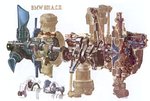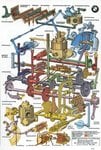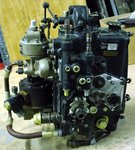....little info on Fw 190 engines..
BMW 801
BMW 801 A, B, C had 156 mm stroke and 156 mm of drilling,41.8 l capacity and 1175 KW (1600 HP)when using 87 octane gasoline,compression ratio of 6,5 and a loader (compressor,blower) translation of 5,07 for low altitude and 7.47 for high altitude (as multiple of the crankshaft speed),the propeller reduction was 0,54,rotation clockwise.One German site states that 801 B had a counter-clockwise rotation for use on multi-engine aircrafts (A-B combination).
The 801 D and G as uprated version were developed. The increase in output was achived with changed loader translation and a higher compression ratio (7,2) combined with 95 octane fuel.The load pressure rose to 1,39 bar (1.27 bar in A version).Outcome is 1270 KW (1730 HP) at 2700rpm.
801 E had 1470KW (2000HP) with same capacity.This was reached by an aerodynamic refinement of the loader, rpm increase and an increased load pressure (1.62 bar up to 5 min long) during take-off power. The engine could hold an output of 1710 HP to 5650 m height.
The last stage of the increase in output was BMW 801 F.It was derived from E and received further improvements, like reinforcement of the crankshaft, increased intake and exhaust valves,increased injection pump and improved internal aerodynamics.Power reached 2400HP.This engine was for TA 152.
BMW 801 had a master control unit (kommandogerat)-actually a mechanical computer- for the engine which regulates rpm, prop pitch, timing, blower speed all in relation to altitude.
p.s.correct me if I have wrong infomation.
BMW 801
BMW 801 A, B, C had 156 mm stroke and 156 mm of drilling,41.8 l capacity and 1175 KW (1600 HP)when using 87 octane gasoline,compression ratio of 6,5 and a loader (compressor,blower) translation of 5,07 for low altitude and 7.47 for high altitude (as multiple of the crankshaft speed),the propeller reduction was 0,54,rotation clockwise.One German site states that 801 B had a counter-clockwise rotation for use on multi-engine aircrafts (A-B combination).
The 801 D and G as uprated version were developed. The increase in output was achived with changed loader translation and a higher compression ratio (7,2) combined with 95 octane fuel.The load pressure rose to 1,39 bar (1.27 bar in A version).Outcome is 1270 KW (1730 HP) at 2700rpm.
801 E had 1470KW (2000HP) with same capacity.This was reached by an aerodynamic refinement of the loader, rpm increase and an increased load pressure (1.62 bar up to 5 min long) during take-off power. The engine could hold an output of 1710 HP to 5650 m height.
The last stage of the increase in output was BMW 801 F.It was derived from E and received further improvements, like reinforcement of the crankshaft, increased intake and exhaust valves,increased injection pump and improved internal aerodynamics.Power reached 2400HP.This engine was for TA 152.
BMW 801 had a master control unit (kommandogerat)-actually a mechanical computer- for the engine which regulates rpm, prop pitch, timing, blower speed all in relation to altitude.
p.s.correct me if I have wrong infomation.





